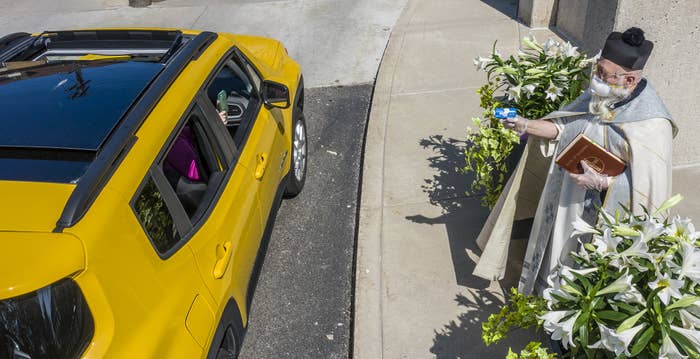A senior Trump administration official said the president rebukes Fauci but supports Birx because 'she is charming and listens to him'
Connor Perrett BUSINESS INSIDER MAY 16, 2020
Flanked by White House coronavirus response coordinator Dr. Deborah Birx (L) and Dr. Anthony Fauci (R), President Donald Trump delivers remarks about coronavirus vaccine development in the Rose Garden of the White House on May 15, 2020. Drew Angerer/Getty Images
The relationship between Dr. Deborah Birx and officials at the Centers for Disease Control and Prevention have sourced as Birx has become increasingly frustrated with the agency and its data, CNN reported.
Officials at the CDC have become irritated with Birx, believing she doesn't do enough to combat misinformation shared by the president, according to CNN.
While Trump has publicly criticized Dr. Anthony Fauci — as recently as Wednesday — he has steered clear of criticizing Birx, who "has his ear," an administration official told CNN.
Visit Business Insider's homepage for more stories.
While the relationship between Dr. Deborah Birx and officials at the Centers for Disease Control and Prevention has reportedly soured, Trump's pandemic adviser has remained in good favor of the president who has privately praised her, CNN reported Saturday.
Birx — the coordinator for the White House Coronavirus Task Force — has grown critical of the CDC, and in recent meetings has said she is frustrated with the agency, two senior administration officials told CNN. She has reportedly taken issue with the way in which the agency gathers data on COVID-19, and believes its data is inaccurate and involves delayed figures on deaths and cases of COVID-19, according to the report.
The CNN report Saturday echoes similar reporting from The Washington Post earlier in May. Birx, who has served as the global AIDS Coordinator for the US since 2014, reportedly told CDC Director Robert Redfield that there was "nothing" that she could trust from the agency.
According to the May 9 Washington Post report, Birx and other administration officials worry the CDC's data-tracking system is inflating coronavirus statistics by up to 25%.
Multiple officials and a source close to the White House task force told CNN said that Birx's tone toward Redfield has recently "shifted dramatically" since she in March defended the CDC for its issuing of faulty COVID-19 tests to states.
Still, Birx has maintained a good working relationship with Trump even when other health experts have drawn public criticism from him, according to the report.
"She is charming and listens to him," a senior Trump administration official told CNN. "She has found a way to shut down his bad ideas without making him feel diminished, unlike Fauci and some of the others."
According to the Saturday report, Trump on multiple occasions has praised Birx.
"It is clear that she has his ear," the official said, according to CNN.
On Wednesday, the president distanced himself from Dr. Anthony Fauci, the longtime director of the National Institute of Allergy and Infectious Diseases who has been at the forefront of the administration's COVID-19 response. Trump disagreed with a portion of Fauci's testimony for Congress that involved the re-opening of schools.
"We have to get the schools open. We have to get our country open. We have to open our country," Trump told Fox News on Wednesday. "You're having bedlam already in the streets — you can't do this. We have to get it open. I totally disagree with him on schools."
He later told reporters: "I was surprised by his answer actually because to me, it's not an acceptable answer, especially when it comes to schools."
Officials told CNN that some within the CDC have grown frustrated with Birx over her apparent refusal to correct some of Trump's misinformation about the virus, while others in the administration reportedly believe Birx acts in her own self-interest.
"From the beginning of her role at the White House, Debbie Birx is out for Debbie Birx," an official said, according to the report.
The relationship between Dr. Deborah Birx and officials at the Centers for Disease Control and Prevention have sourced as Birx has become increasingly frustrated with the agency and its data, CNN reported.
Officials at the CDC have become irritated with Birx, believing she doesn't do enough to combat misinformation shared by the president, according to CNN.
While Trump has publicly criticized Dr. Anthony Fauci — as recently as Wednesday — he has steered clear of criticizing Birx, who "has his ear," an administration official told CNN.
Visit Business Insider's homepage for more stories.
While the relationship between Dr. Deborah Birx and officials at the Centers for Disease Control and Prevention has reportedly soured, Trump's pandemic adviser has remained in good favor of the president who has privately praised her, CNN reported Saturday.
Birx — the coordinator for the White House Coronavirus Task Force — has grown critical of the CDC, and in recent meetings has said she is frustrated with the agency, two senior administration officials told CNN. She has reportedly taken issue with the way in which the agency gathers data on COVID-19, and believes its data is inaccurate and involves delayed figures on deaths and cases of COVID-19, according to the report.
The CNN report Saturday echoes similar reporting from The Washington Post earlier in May. Birx, who has served as the global AIDS Coordinator for the US since 2014, reportedly told CDC Director Robert Redfield that there was "nothing" that she could trust from the agency.
According to the May 9 Washington Post report, Birx and other administration officials worry the CDC's data-tracking system is inflating coronavirus statistics by up to 25%.
Multiple officials and a source close to the White House task force told CNN said that Birx's tone toward Redfield has recently "shifted dramatically" since she in March defended the CDC for its issuing of faulty COVID-19 tests to states.
Still, Birx has maintained a good working relationship with Trump even when other health experts have drawn public criticism from him, according to the report.
"She is charming and listens to him," a senior Trump administration official told CNN. "She has found a way to shut down his bad ideas without making him feel diminished, unlike Fauci and some of the others."
According to the Saturday report, Trump on multiple occasions has praised Birx.
"It is clear that she has his ear," the official said, according to CNN.
On Wednesday, the president distanced himself from Dr. Anthony Fauci, the longtime director of the National Institute of Allergy and Infectious Diseases who has been at the forefront of the administration's COVID-19 response. Trump disagreed with a portion of Fauci's testimony for Congress that involved the re-opening of schools.
"We have to get the schools open. We have to get our country open. We have to open our country," Trump told Fox News on Wednesday. "You're having bedlam already in the streets — you can't do this. We have to get it open. I totally disagree with him on schools."
He later told reporters: "I was surprised by his answer actually because to me, it's not an acceptable answer, especially when it comes to schools."
Officials told CNN that some within the CDC have grown frustrated with Birx over her apparent refusal to correct some of Trump's misinformation about the virus, while others in the administration reportedly believe Birx acts in her own self-interest.
"From the beginning of her role at the White House, Debbie Birx is out for Debbie Birx," an official said, according to the report.




